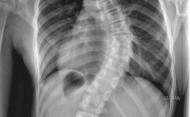 Over 2.7 million visits are made to chiropractors across the U.S, each and every year for treatment of scoliosis and scoliosis-related complaints. These people turn to chiropractic care due to its worthy reputation of being a healer of pain, suffering,its ability to re-align the spine and boost the nervous and immune system. Despite these figures, however, research is still rather inconclusive on just how effect the treatment is for scoliosis.
Over 2.7 million visits are made to chiropractors across the U.S, each and every year for treatment of scoliosis and scoliosis-related complaints. These people turn to chiropractic care due to its worthy reputation of being a healer of pain, suffering,its ability to re-align the spine and boost the nervous and immune system. Despite these figures, however, research is still rather inconclusive on just how effect the treatment is for scoliosis.
A recent study into chiropractic and scoliosis in Michigan highlighted the effective use of chiropractic in the treatment of the condition. The purpose of the study was to report results of 28 patients who competed an exercise-based chiropractic program – essentially concerning the treatment’s potential to alter the natural progression of scoliosis. Conducted at 2 clinics in Michigan, the results were assessed over a 2 year period. Cobb angles (the size of the curvature) were of course measured before and after the treatment and thus later compared for relevant and accurate results and findings.
Therapeutic interventions that were used by the patients were based on Active Reflex Correction in 3 dimensions (ARC3D) and included the use of corrective weights, exercises that rotate the upper body and foam blocks to bring the spine back into alignment. There were 2 milestones in the study, one at 6 months and the other at 24 months, thus allowing professionals to assess the long-term effects of chiropractic care in the treatment of scoliosis.
At the 6 month milestone, 22 of the 28 patients recorded angle reductions of the Cobb – an average of 10 degrees in spinal curvature from a mean curvature of 44 degrees prior to treatment – and even improved dexterity. Results that highlighted just how effective chiropractic care and treatment for this condition is, both in the short and long term. Patients also noted at the 6 month milestone a reduction in pain,and others reported improvements in spinal alignment. A mere 6 of the 28 patients however reported no benefit at all from the treatment.
The Functional Rating Index (FRI) of disability also fell from a baseline average of 60% to 30% at the 6 month check, then 18% at the 24 month milestone. Using a spirometer to measure the lung capacity of all patients before and after treatment, a 7% average increase was observed at the 6 month milestone in lung capacity, however, no further improvement was noted at the final 24 month milestone. Of course it was noted that improvement in curvature, pain and stability tended to be greatest in patients who began the study with the least severe condition. Patients who suffered more severely from the condition and experienced double sized curvature from the others – in the form of an S rather than C shape spine – received no benefit in spinal curvature from the treatment, but, a huge reduction in pain was detected, as was increased mobility.
Nowadays, it is widely stated that chiropractic care is effective in alleviating the pain and discomfort associated with adult and child scoliosis. As this case study suggests, chiropractic care is effective in managing scoliosis curves and both long and short – term results of chiropractic care have proven to be extremely beneficial to patients suffering from the condition.
Denver South Chiropractic
Discover comprehensive chiropractic care in Denver with Dr. Hitender at Denver South Chiropractic. From pain relief to injury recovery, Dr. Hitender offers tailored treatments for optimal health and wellness. Book your consultation today.
Like this article? Spread the word!
Related Posts
April 15, 2025
Straight Talk: Scoliosis Support This Spring
Support your spine this spring with expert scoliosis rehab in Denver. Learn how…
March 15, 2025
Comprehensive Guide to Scoliosis Treatment at Denver South Chiropractic & Rehab
Discover expert scoliosis evaluation and non-surgical treatment at Denver South…





